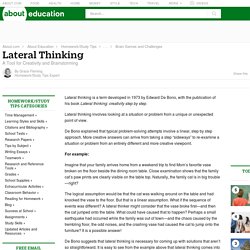

Creative Europe: Frequently Asked Questions. European Commission Brussels/Strasbourg, 19 November 2013 Creative Europe: Frequently Asked Questions (see also IP/13/1114) What is the Creative Europe programme?

Techniques for Creative Teaching – Center for Excellence in Learning and Teaching. Creative teaching In order to teach creativity, one must teach creatively; that is, it will take a great deal of creative effort to bring out the most creative thinking in your classes.

Of course, creativity is not the only required element for creative instructors. They must also know their fields and know how to create an appropriate learning environment. Mind Tools Ltd. Do you want to develop the self-confidence, vision, wisdom, motivational impact and delivery skills that the most effective leaders have?

And do you want to be the person to whom, quite naturally, other people turn for direction? Make your aspirations a reality with this leadership program and learn 48 essential tools you need to be the well-balanced and highly effective leader you aspire to be. The course helps you understand your leadership strengths and weaknesses, and shows you how to manage and capitalize on them. It teaches the skills you need to build a robust and persuasive vision of the future that people will rally to, motivate your team to achieve real success, implement your vision successfully, and develop an ever-more-powerful team. Special offer: Join the Mind Tools Club for just $1 and get this course FREE! Creativity Processes, Creative Thinking and Lateral Thinking from MindTools.com. © iStockphoto/pavlen The tools in this section can help you to become more creative.

They are designed to help you devise creative and imaginative solutions to problems, and help you to spot opportunities that you might otherwise miss. Before you continue, it is important to understand what we mean by creativity, as there are two completely different types. Lateral Thinking - What Is Lateral Thinking? Lateral thinking is a term developed in 1973 by Edward De Bono, with the publication of his book Lateral thinking: creativity step by step.

Lateral thinking involves looking at a situation or problem from a unique or unexpected point of view. De Bono explained that typical problem-solving attempts involve a linear, step by step approach. More creative answers can arrive from taking a step “sideways” How to Apply Lateral Thinking to Your Creative Work. Pretend that you’re trapped in a magical room with only two exits.

Through the first exit is a room made from a giant magnifying glass, and the blazing hot sun will fry you to death. Through the second door is a room with a fire-breathing dragon. Which do you go through? The first door, of course. Simply wait until the sun goes down. The answer to this puzzle is an example of what psychologists call “lateral thinking.” [Ed. note: this post is inspired by Shane's book Smartcuts: How Hackers, Innovators, and Icons Accelerate Success, available on Amazon now.]
Like our magical room, marketers have a bad habit of charring great terms to death. “We assume certain perceptions, certain concepts and certain boundaries,” explains Edward de Bono, who coined the term in 1967. Thinking Methods: Lateral Thinking. His contra-logical approach has become a well established part of most, if not all, of today's creative thinking methods and approaches.

Description: Lateral Thinking is a deliberate, systematic creative-thinking process that deliberately looks at challenges from completely different angles. By introducing specific, unconventional thinking techniques, lateral thinking enables thinkers to find novel solutions that would otherwise remain uncovered. Lateral thinking focuses on what could be rather than what is possible and centers around four directives: Recognize the dominant ideas that polarize the perception of a problem.Search for different ways of looking at things.Relax rigid control of thinking.Use chance to encourage other ideas Seven techniques or mental tools help carry out these directives with the goal of eliciting unpredictable ideas, which may turn out to be novel and useful solutions to the problem being addressed.
Techniques for Creative Teaching – Center for Excellence in Learning and Teaching. 101 Ways For Teachers To Be More Creative. 101 Ways For Teachers To Be More Creative Ed note: This post has been republished from a 2013 post.

Creativity isn’t always something that just happens. It can take quite a bit of work to nurture, grow, and develop creativity, even for those who are immersed in creative and dynamic fields. For educators, it can be even more of a challenge to inspire creativity in students or embrace your own creativity while trying to juggle academic requirements, testing, and other issues in the classroom. It may be difficult but it’s certainly not impossible, and accomplishing it can help to create a classroom environment that’s more motivational, interesting, and educational for both you and your students.
So how do you get there? Not sure where to begin? BE OPEN TO NEW IDEAS.Even the most open-minded of us sometimes get stuck in a rut and can’t see that there are other, potentially better ways of doing things. Education; Vertical Thinking – Lateral Thinking. “You cannot dig a hole in a different place by digging the same hole deeper.”

Edward DeBono In the last post “Race to NOwhere – NOWhere” our students are falling asleep in their one dimensional learning rooms. What the chalkboards and rows of desks lack is creativity and excitement in thinking and problem solving. We are a nation whose public school system is churning out vertical thinkers in an age of 21 year old internet multi-millionaires, who are thinking laterally, way ‘outside the box’. These lateral thinkers are changing the millennium.
Vertical thinking, which is the primary thinking method practiced in the American public school system, is a method of the Industrial Age, not the High Tech Age.